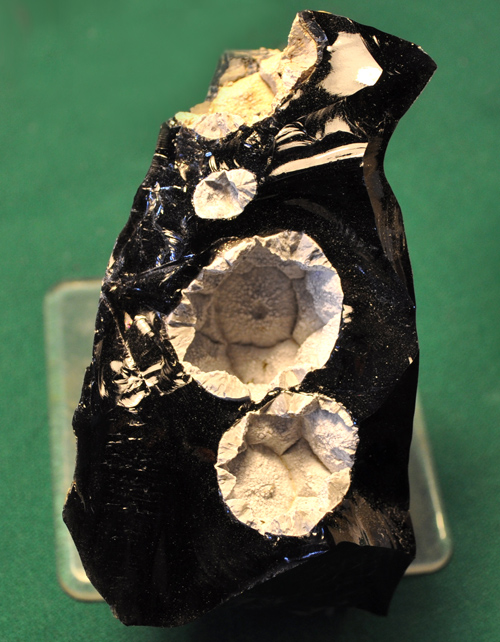The Mineral cristobalite

Cristobalite is an odd form of silica. It is composed of the same elements as Quartz but has a different crystal structure, making it a separate mineral. Cristobalite is found in volcanic sources almost always associated with the natural glass rock obsidian. It usually forms in vesicles and gas pockets with the obsidian.
Snowflake obsidian, a popular form of obsidian with white snowflake-like formations on it, is in fact obsidian with small white inclusions of Cristobalite, where the white microscopic crystals form a pattern giving it a snowflake-like effect.
Color
White, light gray, light yellow, light brown, blue-gray
Crystal System
Tetragonal
Crystal Habits
Cristobalite is a always a pseudomorph after Beta Cristobalite, which crystallizes in the isometric system, and thus Cristobalite occurs in isometric shaped crystals.
Click here for a detailed explanation on the crystal structure of Cristobalite and other forms of silica.
Crystals are usually in microscopic grains, and small octahedral crystals can be made out under magnification. The octahedral crystals may be twinned with Spinel twinning. Cristobalite is much more common in globular groups and as crusty rounded balls. It also occurs massive, platy, crusty, and stalactitic. Crystals are occasionally cubic.
Uses
Cristobalite is used in scientific study. Its crystals provide key information to how crystals form, and how they change over in different environments.
Noteworthy Localities
Cristobalite is named after its original occurence of Cerro San Cristobal, Pachua, Mexico. It is also found in the Caspar Quarry (Bellerberg) in the Eifel Mts, Germany; and in Lipari Island, Sicily, Italy.
In the U.S., the two most famous occurrences are in California at Coso Hot Springs, Inyo Co.; and at Cougar Butte, Siskiyou Co., where it occurs in both these places as white pockets in obsidian. Other localities are Obsidian Cliff in Yellowstone National Park, Wyoming; Mt. Lassen in Lassen Volcanic National Park in California; Crater Lake National Park, Klamath Co., Oregon; and the Thomas Range, Juab Co., Utah.
Distingushing Similar Minerals
Cristobalite's formations and mode of occurrence can distinguish it from most other minerals.